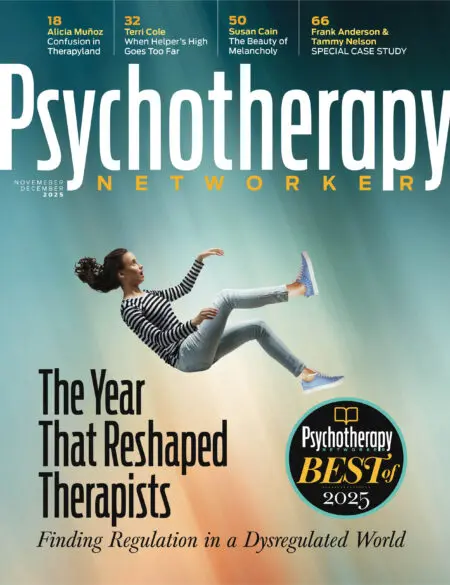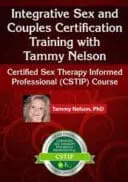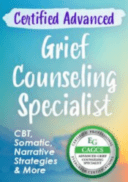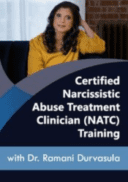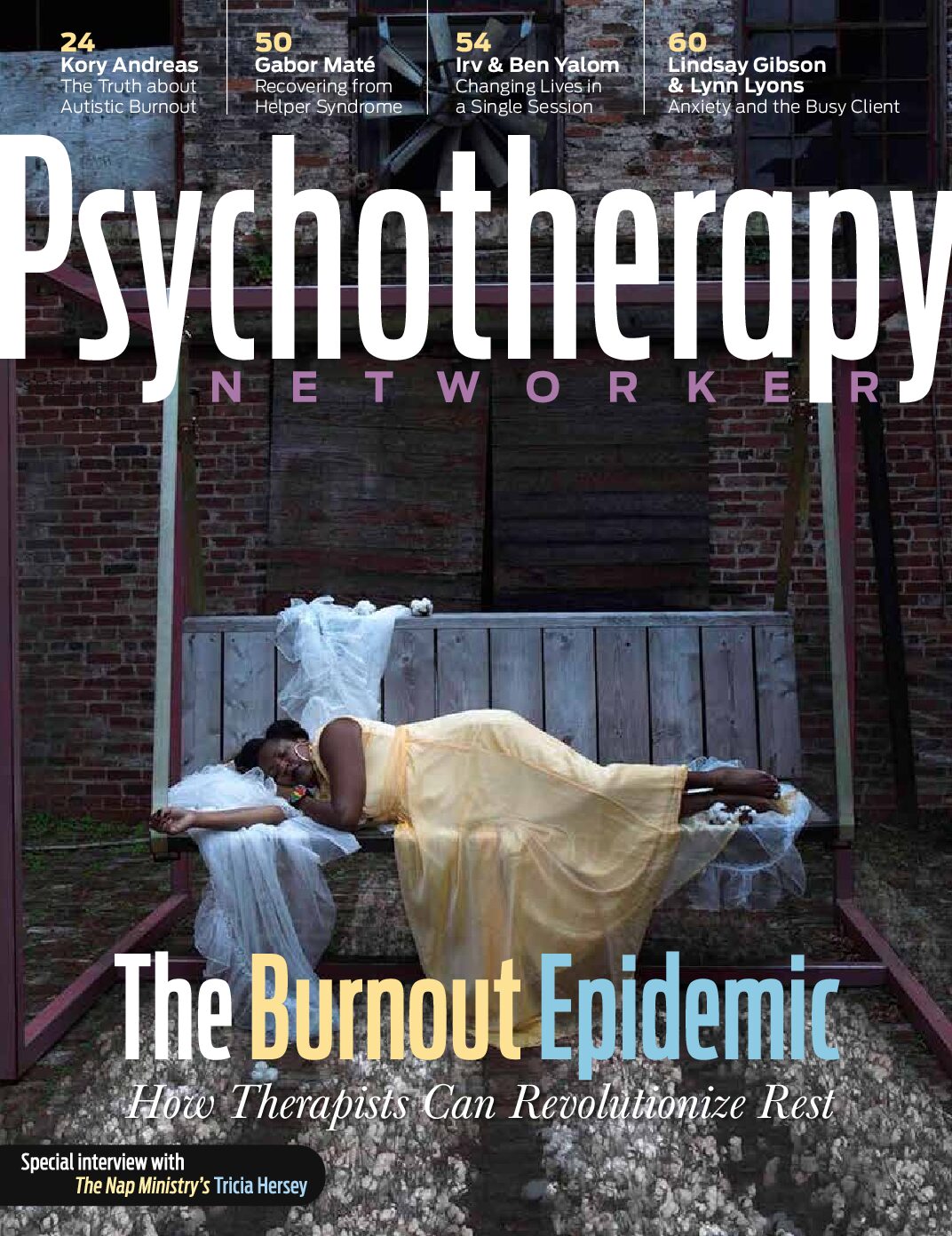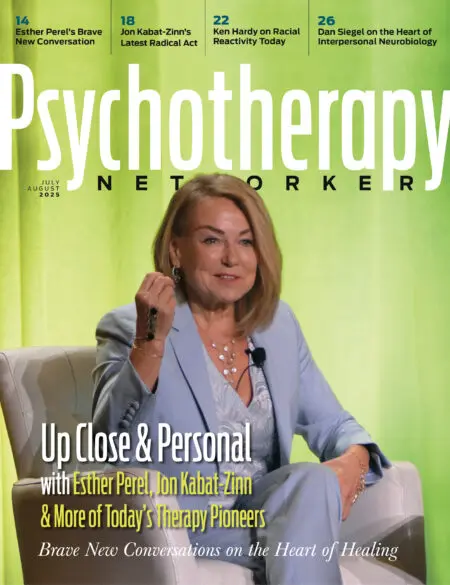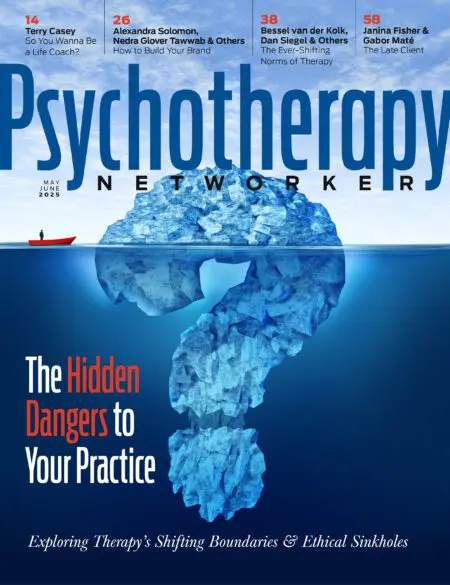Enjoy the audio version of this article—perfect for listening on the go.
Ten years ago, when we last dedicated an entire issue of this magazine to exploring burnout, the topic felt interesting, yes, but also limited. At the time, burnout just seemed like a novel word therapists were using to describe the nebulous yet nagging feeling of being uninspired and overworked. And the antidote sounded simple enough: self-care. The image we chose for that cover was of a single extinguished candle—clad, somehow, in a suit and fancy red tie.
A few things were wrong with that picture. Aside from the unfortunate implication that only a privileged, tie-wielding businessman could experience burnout, it inferred that burnout was an individual problem: as in, when an individual burns out, it must be because that individual is mismanaging their work-life balance. As such, burnout registered on most of our clinical radars as no more than a blip. We saw it as entirely fixable, if only people would prioritize taking walks at lunch or maybe even a regular bubble bath with a gratitude journal.
These days, however, those individual blips have multiplied, grown, and morphed. Rather than a single extinguished candle, burnout feels more like an active wildfire, indiscriminately ripping through our natural human resources. Everyone’s burning out—therapists (from every corner of the mental health field), clients (toiling in all sectors of our economy), parents (working or otherwise), influencers (from advocates to wellness coaches), teachers (underpaid in every school), and even kids (faced with complex mental health challenges at earlier and earlier ages). We’re seeing astounding rates of burnout in marginalized populations, as well as in the Autistic community, where sensitive nervous systems are being pushed into complete collapse. Burnout. Even the term itself, strewn across endless book covers and news headlines, seems tired amid this crisis, ready to lay down in the lexicon graveyard where overused words go to lose all meaning.
Maybe it’s a new form of compassion fatigue, but over the past few years, I found myself starting to burn out on the whole problem of burnout. After all, no one I know still believes individual self-care is the ultimate panacea—it’s more like a Band-Aid that keeps falling off—and I hadn’t heard any other ideas about how to address it that even came close to touching on the enormity of the problem. Then, I met Tricia Hersey, creator of The Nap Ministry, and my view of burnout completely changed.
In Hersey’s latest book—a work of stunning visual art, trailblazing ideas, and radical poetry—she calls burnout “a scam, a language created by agents of grind culture, tricking you into believing it’s a normal and regular part of any working person’s career.” The way to “peep this scam,” she writes, is to tap into your trickster energy and . . . wait for it . . . rest. Yes, rest. Sleep, doze, daydream—it doesn’t matter how you do it. What matters is that you recognize your rest as an act of resistance against the systemic injustices that are burning us out. This idea is larger than self-care. It’s defiance via daydream.
Other standout stories we’ve put together for this issue echo this call to awaken your inner trickster and dream big. Roger Kuhn, for instance, offers up the idea of taking a rock & roll sabbatical. This doesn’t just mean a weekend off from your practice, or even a few weeks. Rather, he proposes taking a long break, a year in his case, to reconnect with parts of your creative self you’ve set aside to focus on your clients and clinical practice. If this sounds tempting but completely impractical, you can read about the highly practical steps he took to make sure that while he was on sabbatical, his clients would be taken care of, his living expenses would be covered, and he’d have a practice to return to as a less burned out, more integrated therapist.
Another norm-bucking way to fight burnout, several of our authors argue, is to widen the scope of self-care to community-care. What does this mean for suffering clinicians, who already take care of so many people both on their caseloads and in their personal lives? It means taking care of each other by rethinking the structure of our field in ways that prioritize therapist wellbeing. It means creating nonjudgmental spaces where we can talk freely about the job-related grief and trauma we experience after a client loss or suicide. As we well know, and would tell any client, isolation only intensifies self-blame, so we need to make a conscious effort to break the silent shame around distressing experiences that are universal in our profession. Why not let ourselves dream about training programs that center healing for the healers? If more of our dreams made their way into reality, would we see fewer therapists burning out from the important work we do?
And in the meantime, let’s remember that no one’s throwing the self-care baby out with the bathwater. We can still do things for ourselves that nurture our spirit and enhance our presence as therapists, which we highlight in stories about exploring micro self-care, recalibrating your empathy dial, and tapping into the power that entrepreneurship can offer struggling therapists in general and Black therapists in particular. In the end, as Sarah Buino writes in her article on the healing ripple effect: “This is how we start the revolution. First inward, then outward, one step at a time.”
So find a comfortable place to rest as you sink into this issue, and let’s daydream together.
Livia Kent
Livia Kent, MFA, is the editor in chief of Psychotherapy Networker. She worked for 10 years with Rich Simon as managing editor of Psychotherapy Networker, and has collaborated with some of the most influential names in the mental health field on stories that have become widely read articles and bestselling books. She taught writing at American University as well as for various programs around the country. As a bibliotherapist, she’s facilitated therapy groups in Washington, DC-area schools and in the DC prison system. In 2020, she was named one of Folio Magazine’s Top Women in Media “Change-Makers.” She’s the recipient of Roux Magazine‘s Editor’s Choice Award, The Ledge Magazine‘s National Fiction Award, and American University’s Myra Sklarew Award for Original Novel.
